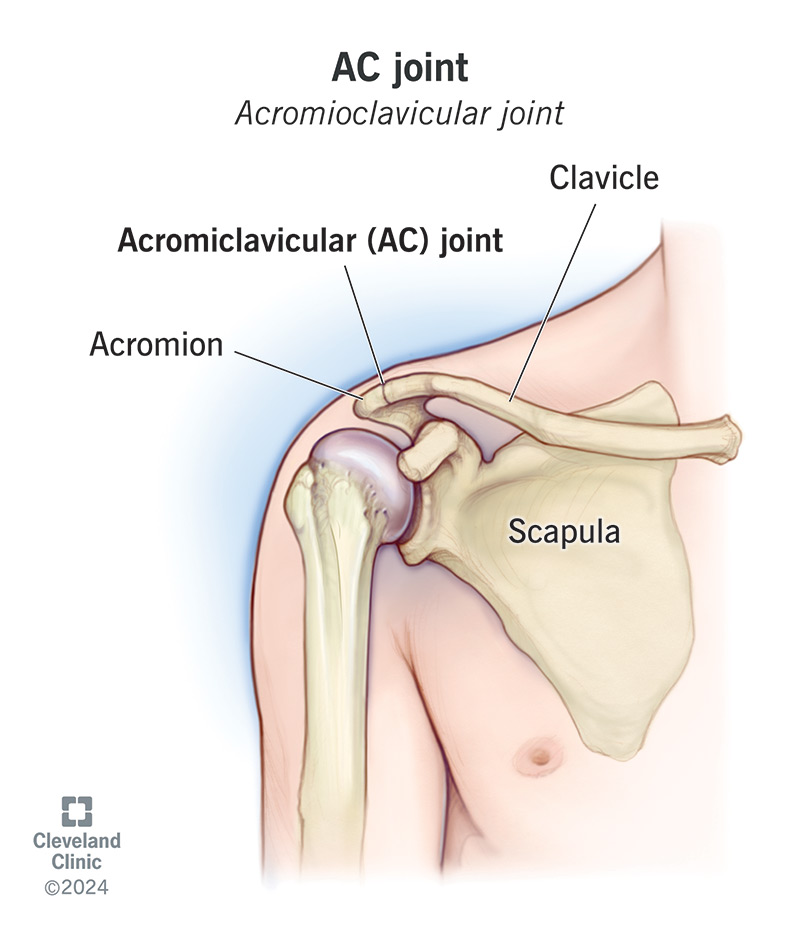The AC (acromioclavicular) joint is part of your shoulder. It’s the joint where your collarbone connects to your shoulder blade. It helps you move your arms front to back and tilt them up and down. AC joint injuries are the most common shoulder injuries. Visit a provider if you’re experiencing new or worsening symptoms like pain and stiffness.
Advertisement
Cleveland Clinic is a non-profit academic medical center. Advertising on our site helps support our mission. We do not endorse non-Cleveland Clinic products or services. Policy

The AC joint is one of two joints that make up your shoulder. It’s where the acromion (the top part of your shoulder blade) meets your clavicle (collarbone). That’s where the AC joint gets its full name — the acromioclavicular joint.
Advertisement
Cleveland Clinic is a non-profit academic medical center. Advertising on our site helps support our mission. We do not endorse non-Cleveland Clinic products or services. Policy
The AC joint’s main job is supporting your shoulder and acting as a connection point for ligaments around your shoulder.
Your acromioclavicular joint is a passive joint. That means all its movements are controlled by other muscles and joints. In this case, your shoulder muscles move the rest of your shoulder, which then moves your AC joint. It’s a planar joint — a type of joint that lets two bones glide smoothly past each other.
When your shoulder muscles move your shoulder, the AC joint helps your shoulder move from back to front (anteroposterior). Picture using your shoulder to do a rowing motion, pushing your arms out away from the front of your body, then pulling them back in so your elbows move behind you.
The AC joint is at the top of your shoulder. It’s where the outermost point of your collarbone connects to the front of your shoulder blade.
The acromioclavicular Joint includes:
Advertisement
AC joint injuries are very common. Experts estimate that around 40% of shoulder injuries affect the AC joint, including:
Anything that puts a lot of sudden force on your shoulder can damage your AC joint. Sports injuries and trauma like car accidents and falls are the most common causes.
Arthritis can develop in your acromioclavicular joint. But many people never feel pain or other symptoms. You might not need treatment or ever know you have AC joint arthritis.
When you’re experiencing shoulder pain, it might be tough to say for sure it’s in your AC joint.
Even if you know what the acromioclavicular joint is and exactly where it is, when your shoulder hurts, it’s not easy to pinpoint the exact place it’s coming from (where the pain originates).
You might feel pain right in your AC joint, but it may spread (radiate) to your neck, lower in your shoulder or to muscles in your chest or back.
What AC joint pain feels like will depend on what’s causing it. The pay may feel:
It’s perfectly normal for your joints to pop or crack sometimes. These noises are usually nothing more than gas trapped in the synovial membrane getting squeezed out. You don’t need to worry if you feel or hear a joint pop when you’re stretching or moving.
But if you hear or feel a pop when you fall or take a hard hit during a sport, you should see a healthcare provider — especially if your shoulder hurts or you can’t move it after the pop. Those kinds of pops can be from dislocations or separations. Visit a provider if your shoulder pops in exactly the same way every time, or if you can feel a grinding when you move.
Don’t let anyone other than a trained healthcare provider touch or push on your shoulder if you think it’s injured. Never try to force your shoulder back into place if you think it’s dislocated or separated. Try to hold it steady and as still as possible and go to the emergency room right away.
Which treatments you may need will depend on the injury or issue you have. Your healthcare provider will suggest treatments to manage any symptoms you’re experiencing and help your AC joint heal. Some of the most common treatments include:
Advertisement
The best way to take care of your AC joint is to maintain good overall health, including:
Your shoulder is such a complex joint because it helps you do so much. It can move further (and in more directions) than any other joint in your body. The AC joint is part of that. It supports your shoulder and helps you move.
You probably won’t have to think about your acromioclavicular joint unless you experience an injury or have a health condition that affects your joints. That doesn’t mean you should ignore pain, stiffness or any other symptoms. Visit a healthcare provider if your shoulder isn’t feeling quite right. They’ll help you understand what’s wrong and which treatments will get you back to feeling like yourself.
Advertisement
Last reviewed on 11/06/2024.
Learn more about the Health Library and our editorial process.